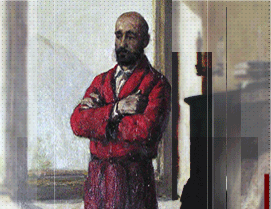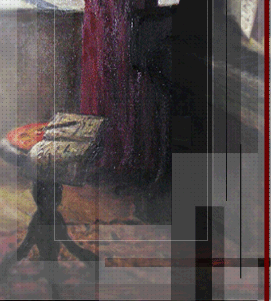KOMITAS'
SOLO ARRANGEMENTS
The primary part of Komitas'
musical legacy consists of his treatments of authentic folk songs.
The creative treatment of folk melodies was a genre that especially
attracted Komitas. Komitas can be called a true folk artist, having
mastered the rules and features of folk song creation. In fact,
he appears as a keeper of folk music classical traditions who remakes
and improves peasant folk melodies by using the expressive means
of contemporary professional musical art.
"I strongly believe that before setting to remake Armenian
folk songs, one should deepen his knowledge of the historical and
day-to-day living conditions of his people; one should decipher
the musical structure, essence and style, the meanings of the words,
and be aware of the unique qualities of our folk verses, style of
folk singing and many other facts. Only then can one launch a treatment
and publication of the songs; otherwise there will be flaws and
shortcomings".
These words by Komitas entirely correspond to his own experience
of working with his native people. That is why, through his treatments
of songs, he has made a great contribution to Armenian professional
music. In general, Komitas has only one theme for his creations,
that is, Armenian peasantry, although in different genres this theme
is presented through various aspects and unique displays.
Series of lyrical songs for voice and piano such as "Keler-tsoler",
"Kele-Kele", "Chinar es", "Kuzhn ara",
etc. gained wide recognition both in Armenia and abroad. In the
song "Keler-Tsoler" the girl praises her fair-haired beloved
mowing the grass. She admires his step, manliness and labor, and
his wonderful image is compared to the landscape of a mountain meadow and with nature in general.
"Kele-Kele" is a more complicated and dynamic song. In
its center, two images are contrasted: an energetic, manly image
and a tender, feminine one. The young man glorifies his darling
- "his tender dark quail". He admires everything: her
step, sharp mind and slenderness. Komitas achieves a contrast of
the two images by applying modal changes. The same changes are used in the song "Chinar es". There is no contrast
here, only a vast lyrical state with a range of nuances.
In the song "Kuzhn ara", Komitas achieves even more integrality.
A fine, poetic piano accompaniment creates a transparent background
for the affectionate and simple melody, i.e. the song of a girl
looking forward to meeting her darling. These four pearls are examples
of light-hearted lyrics, but in Komitas' work, one can find lyrics
of another type: dramatically tense, mournful and tragic.
The song "Garun a" brightly expresses such a sphere of
feelings. The theme of the song is the tragedy of an abandoned girl.
Here nature and the realm of personal feelings go in parallel like
two identical worlds: in spring, when everything must blossom, it
suddenly starts snowing, and a girl whose love has just blossomed
is abandoned by her beloved.
In "Garun a", Komitas' creative approach is more complicated.
Now it can be described as s dynamic work based on folk music rather
than a simple correction or purification of this music. Komitas
turns "Garun a", a restrained mournful song, into a profound
dramatic composition, both saturated and strong in its expression.
And, if in other songs, Komitas frequently treated the piano accompaniment as a background or sort
of emotional "tuning", for this song, he wrote a comparably
extensive four-bar introduction bearing an independent idea. Here
the main four-note motif gradually tenses and becomes more vibrant.
"Garun a" in Komitas' treatment brilliantly testifies
to his mighty talent of creating tragic works of great artistic
value.
Another branch of Komitas' lyrical songs includes poetic sketches
of Armenian nature and landscapes. By their common frame of character,
these songs continue along the enlightened, lyrical line, especially
as the love theme in folk songs is always closely related to images
of nature. The lyrical daily song "Alagyaz" is one such
musical picture. It portrays a number of Armenian nature sketches
following one after another, such as the gorgeous and stately Mount
Alagyaz surrounded by clouds, a sudden rainfall and the sun looking
out from behind the clouds and warming up everything.
The song "Es arun" is also a musical "picture":
one can hear the playful murmur of a stream. The piano accompaniment
plays the leading descriptive role: slight wave figures illustrate
a stream, softly talking and running amongst mountainous stones.
Komitas worked out this gentle miniature with limited means but
in excellent taste.
Special consideration among Komitas' treatments is given to a song-cycle
concerning people's grief and suffering. The social theme sounds
here especially boldly. These songs, replete with a solemn eminence,
are about numerous cases of distress, wars, oppression, ravage,
poverty, and expatriation that have occurred in Armenian history.
The main character and victim in these songs is a wanderer, "pandukht",
a deprived exile compelled to drag out a dreary existence and longing
for the happy day when he will again be blessed with his own home
and peace. Undoubtedly, "Antuni" is the most prominent
representation of the cycle. Nonetheless, it is still not known
for certain whether the song is a treatment or an original work
by Komitas. Researchers' opinions on this subject differ.
Very frequently the wanderer's image is compared with that of a
crane ("krunk" in Armenian). That is why in the songs
of the Antuni ("homeless", "wanderer") type,
we encounter Krunk as the main character who is always waiting for
a homeland and who dreams of flying back and building a nest at
home.
"Kanche Krunk", one of the best treatments in the cycle,
is an innovative work bearing a seal of immense creative inspiration.
Komitas' treatment is strict and simple and thus highlights the
poetic beauty and deep authenticity of the folk melody with its
rhythmic and modal diversity.
The famous and much loved treatment "Tsirani Tsar" ("Apricot
Tree") occupies a special place in the cycle of grief-filled
yet heroic songs. It is a tragic song which tells of a deprived
peasant. In fact, "Tsirani tsar", an infinitely developed
composition with a great number of repetitions, unites three songs
according to Komitas' composition plan. The foundation is the song
"Tsirani Tsar" itself, in its entirety, emotionally and
psychologically concentrated. The melody of the song reveals many
features assembled in Armenian folk music. And that is the reason
for such an ordinary merging of the two other songs: "Tvek,
et tvek" ("Give back") and "Hov, Hov, Hovn enkav"
("Evening Freshness Fell"). More modest in depth, character
and expression, they serve as superb expansion of the main song.
|


